Nearly everyone who lives in or visits Provincetown knows about its vibrant artistic community. Far fewer know the names and faces of the artists who compose it.
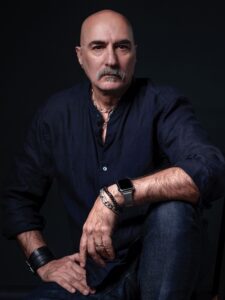
“I didn’t know who most of these artists were when I began the project,” says New York-based photographer Ron Amato, whose portraits of Provincetown artists, writers, and performers in their studios, homes, and various places around town are the subject of a new book and accompanying exhibition at the Provincetown Art Association and Museum.
“I didn’t know the history,” he says. “That’s one of the reasons I started it. I wanted to get to know this place better.”
Curated by artists Midge Battelle and Pasquale Natale — both of whom are among Amato’s subjects — the exhibition includes portraits of 84 artists spanning generations and disciplines. In its subject and scale, the project continues the achievement of photographer Norma Holt (1918-2013), who photographed more than 100 artists, writers, poets, and other Outer Cape creatives. Her work was published and exhibited at PAAM as “Face of the Artist” in 1980.
“When I first saw her work, I was floored,” says Amato, who was introduced to Holt’s project by artist John Dowd. “I really got to know the history of Provincetown from that book. I used it as sort of a bible to find the artists who were still alive I wanted to photograph. I thought it was important to include as many of her subjects as I could.”
Amato eventually photographed 27 artists whom Holt had photographed nearly a half century before. “It was really important to me to get Pat de Groot,” he says. “It was toward the end of her life. The photograph of her that wound up in the book was the one that most captured her personality for me.” De Groot died in 2018.

Other artists in both collections include Paul Bowen, Barbara Cohen, Salvatore and Romolo Del Deo, Anne Packard, Marian Roth, and Bert Yarborough.
Along with Holt’s book, Amato relied on introductions to determine which artists to photograph for his project — which he acknowledges is incomplete. “I learned as I went,” he says. “Some artists would lead me to still other artists, and things grew from there. But I know I didn’t find everyone. In Provincetown, I think that would be impossible.”
While Holt’s influence is evident in Amato’s series, its strongest stylistic antecedent is American photographer Arnold Newman (1918-2006), who is regarded as the leading proponent of the concept of “environmental portraiture.” In portraits of celebrities, politicians, and artists of his day, Newman emphasized the settings and even objects associated with his subjects as much as the subjects themselves.
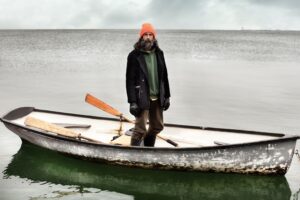
“Newman established the visual language of environmental portraits in the 20th century,” says Amato. “I really take my visual cues from him.”
In many ways, the photographs are about the physical spaces of the Outer Cape: the golden early morning light that envelops Jim Broussard on MacMillan Pier; the veritable landscape of detail in the brushes, tubes, and swatches of paint on Robert Henry’s well-worn studio workbench; the dune shack — at once sturdy and vulnerable — that frames Helen Grimm. The artists appear in active dialogue with their surroundings.
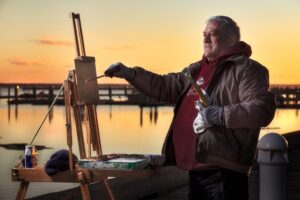
Determining the location for each portrait was collaborative. “I never dictated where I wanted to photograph anyone,” says Amato. “Before this project, the process was all about my decisions. These are more collaborative because I needed the artists’ peace of mind to be a part of the image. The emotional state they’re in when I’m making pictures is important.”

In many cases, Amato says, it just felt right to photograph artists where they worked. Accordingly, studio spaces figure prominently in the series. But some artists suggested other places in the environment that resonated with them. “Donald Beal took me to a place in the Beech Forest that inspired him,” says Amato. “Jim Broussard told me he often painted on the pier.”
Still other settings revealed themselves serendipitously. “Having Sue Goldberg pose in an alley in the center of town also just felt right somehow,” he says.
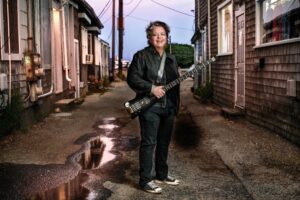
The project also chronicles Amato’s own relationship with Provincetown over the years. Unlike Holt, who was already a member of the Provincetown art community when she photographed her subjects, Amato began the project with the curiosity of an outsider.
Amato, a professor in the Photography and Related Media department at the Fashion Institute of Technology in New York City, first visited Provincetown in 1999. Initially, his work here focused on nude male studies in the dunes and forests of the Outer Cape, a body of work for which he is perhaps best known. He made his first portraits of artists in 2015.
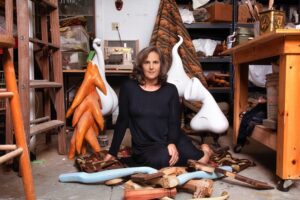
“I was restless, and I wanted to explore another aspect of the town,” says Amato. “I was photographing in nature for a very long time. Then I started moving indoors, which dovetailed into the artist project. It’s enabled me to explore more places in Provincetown than I’d known about before. Wanting to get to know the artist community here — and wanting them to get to know me — was a big motivation.”
“Artists of Provincetown” is both a personal achievement and an important historical document: a collective snapshot of Provincetown’s artist community at a particular point in time. “The book is important now,” writes Michael Cunningham (another of Amato’s subjects) in his introduction, “and it’ll be important in the future, as a record of those who found their way to a town on a remote spit of sand and produced work that will endure, even after its creators are gone.”
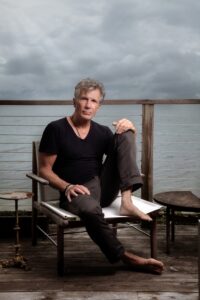
Amato echoes Cunningham’s view. “I hope it makes the artists in these photographs feel a stronger sense of the legacy they share and the community they’re part of,” he says. “I hope people in town who don’t know that this community exists among them will see it. And I hope that visitors who have a more casual relationship to Provincetown will see what’s here in a different way. I’m proud to be tied to making that happen.”
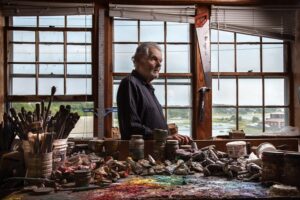
Photographs by Ron Amato
The event: ‘Artists of Provincetown’
The time: Through Aug. 18; Wednesday through Monday 11 a.m. to 5 p.m., Fridays to 8 p.m. (closed Tuesdays)
The place: Provincetown Art Association and Museum, 460 Commercial St.
The cost: $15 general admission; free on Fridays from 5 to 8 p.m.; see paam.org
